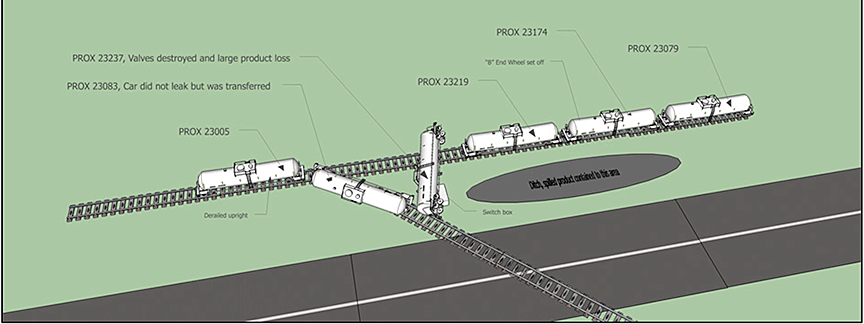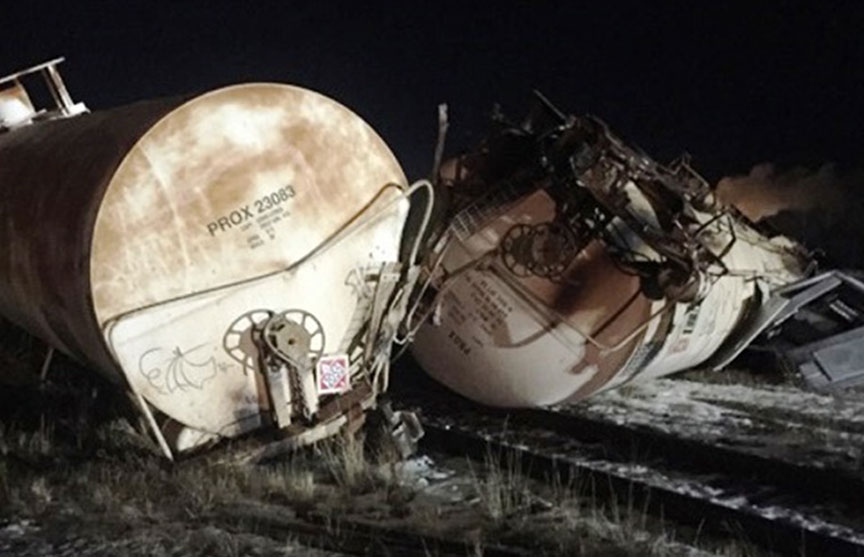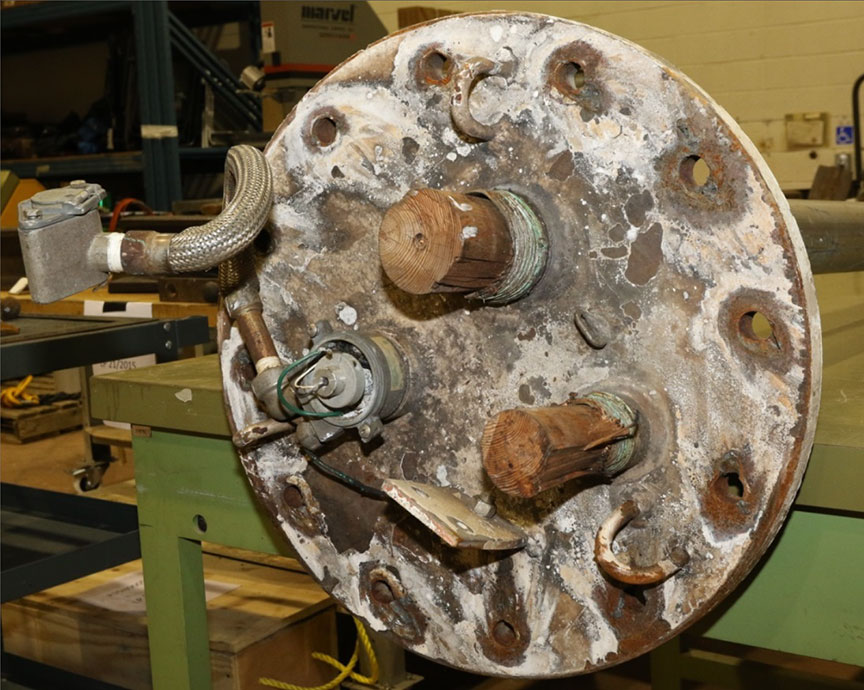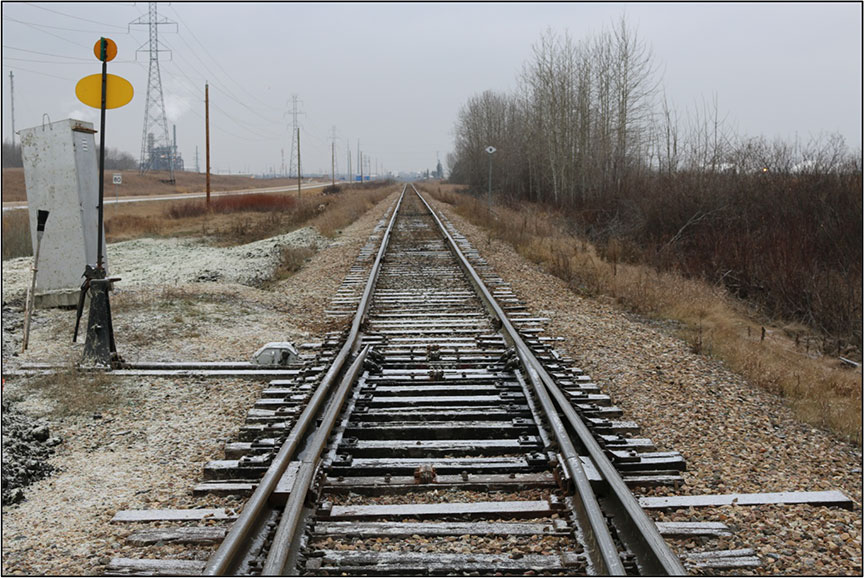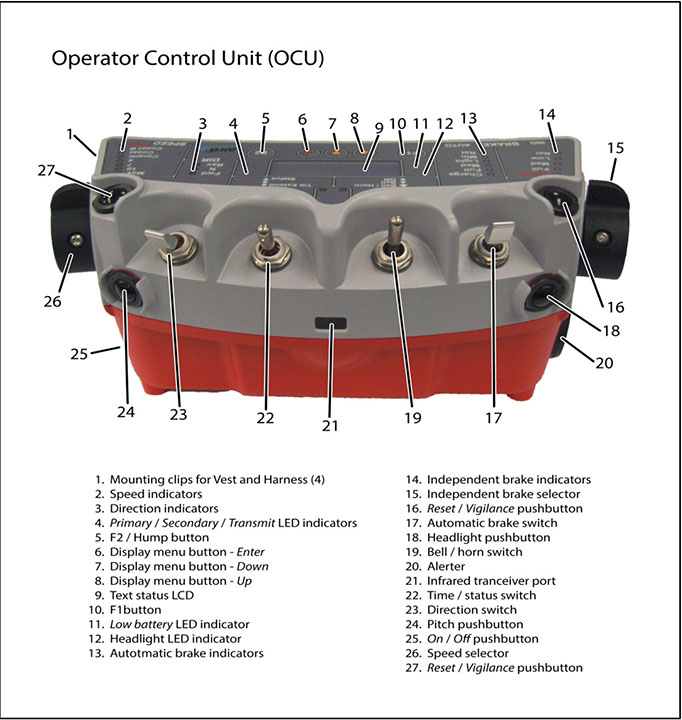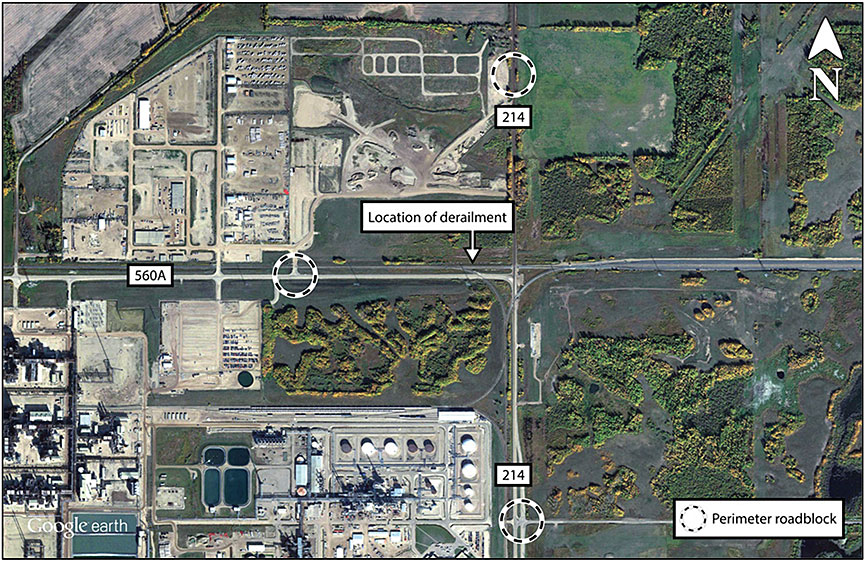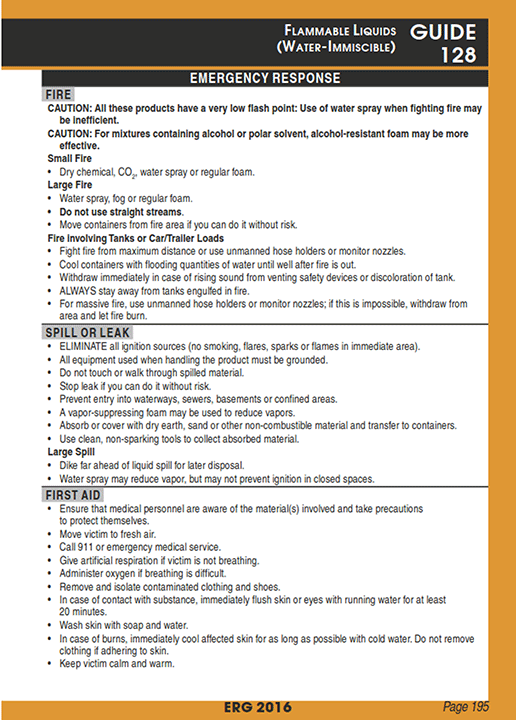Non–main-track derailment
Canadian Pacific Railway
Switching assignment AS-01
Mile 138.0, Scotford Subdivision
Scotford, Alberta
The Transportation Safety Board of Canada (TSB) investigated this occurrence for the purpose of advancing transportation safety. It is not the function of the Board to assign fault or determine civil or criminal liability. This report is not created for use in the context of legal, disciplinary or other proceedings. See Ownership and use of content. Masculine pronouns and position titles may be used to signify all genders to comply with the Canadian Transportation Accident Investigation and Safety Board Act (S.C. 1989, c. 3).
Summary
On 08 December 2015, at about 1515 Mountain Standard Time, Canadian Pacific Railway switching assignment AS-01, which was being operated by a remote control locomotive system, derailed 4 loaded tank cars while performing switching operations. Two cars remained upright, 1 car came to rest on its side, and 1 car rolled into a ditch, coming to rest upside down and releasing most of its contents. The cars contained styrene monomer, stabilized (UN2055), a Class 3 flammable liquid. The released product was confined to the ditch. There were no injuries.
Le présent rapport est également disponible en français.
Factual information
The accident
On 08 December 2015, switching assignment AS-01, which was being operated by a remote control locomotive system (RCLS), was working with 2 locomotives at the west end of Canadian Pacific Railway's (CP) Scotford Yard in Scotford, Alberta (Figure 1). Scotford Yard is situated at Mile 138.1 on the Scotford Subdivision. The assignment, which originated at Scotford Yard, was servicing petrochemical companies in the local industrial area.
At the beginning of the shift, the crew, consisting of a yard foreman and a yardman, had operated the assignment westward with 22 cars from the Old Yard to service Shell Canada's Scotford Upgrader (Figure 2). After servicing the upgrader, the assignment departed with 28 cars. On the return move, the crew decided to wyeFootnote 1 the movement, which would reorient the locomotive consist so that the controlling locomotive faced westward, which was the orientation the crew was most familiar with.Footnote 2
To wye the movement, the following steps were taken:
- The movement diverged onto the west leg of the wye and continued southward on the Canadian National Railway (CN) Glycol Lead until the last car cleared the south wye switch.
- The south wye switch was then reversed, and the movement was shoved northward, diverging onto the east leg of the wye.
- The east wye switch was reversed to line the movement into the Old Yard.
- The east wye switch was then restored to normal for westward movements.
Both crew members were on the leading end of the movement for the return to the yard via the east leg of the wye. The movement arrived back at the Old Yard at about 0930.Footnote 3
About 6 hours later, at approximately 1510, the crew had to make a westward movement toward the wye, as the tail-end car of the movement had to clear yard track switch No. 2. The movement, comprising 2 locomotives and 32 loaded cars, weighed 4362 tons, was 1942 feet long, and was being operated with the air brake systems connected and charged. During this movement, the yard foreman, who was operating the RCLS, was positioned on the ground at yard switch No. 2, waiting for the last car of the movement to clear the switch. The yardman, who was in the cab of the lead locomotive, was in position to provide protection when operating over the public crossing at Range Road 214.
The crossing was protected with automatic warning devices (AWD) that included flashing lights and a bell. While the AWDs were activated and the movement was approximately 100 feet from the crossing and travelling at about 4 mph, a vehicle proceeded southward over the crossing in front of the movement.
After operating over the crossing, over about the next 90 seconds, the movement continued westward a further 600 feet towards the west wye switch. As the movement was on tangent track, the sightline towards the west wye switch was clear. From the head end locomotive, the switch target was visible from at least the crossing location. The west wye switch was lined against the movement. The yardman in the locomotive cab did not observe either the reversed switch points or the yellow switch target. No action was taken to stop in advance of the west wye switch. As the movement continued westward, the 2 locomotives and the first 18 cars trailedFootnote 4 through the west wye switch, forcing the switch points over and damaging the switch. When the tail-end car cleared yard switch No. 2, the movement was brought to a stop. Yard switch No. 2 was then reversed, allowing the movement to be shoved eastward.
Unaware that the west wye switch had been damaged, the crew started to shove the movement eastward, resulting in the derailment of 4 tank cars at approximately 1525. During the derailment, the brake pipe disconnected and the air brakes applied in emergency,Footnote 5 bringing the movement to a stop. The crew immediately provided site protection and made an emergency call to the CP supervisor at Lambton Park in Edmonton, Alberta. Noting that product had been released, the crew also contacted Shell Canada, which deployed its emergency response team to the site.
Site examination
The 4 tank cars involved in the derailment (PROX 23005, PROX 23083, PROX 23237, and PROX 23174) were loaded with styrene monomer, stabilized (UN2055), a Class 3 flammable liquid.Footnote 6 Two of the tank cars had derailed in an upright orientation (PROX 23005 and PROX 23174) and were subsequently placed back on the rails (Figure 3). PROX 23083 was damaged and had come to rest on its side (Figure 4). The product from this car was transloaded in place into 3 highway tank trucks and then transferred into another tank car. Tank car PROX 23237 had rolled over into the ditch adjacent to the track, coming to rest upside down. The liquid line and the vapour line were sheared off during the derailment (Figure 5), and approximately 87 000 litres of product were released into the ditch. About 6000 litres remained in the breached tank car and were later recovered.
The frozen ground at the site kept the released product in the ditch. Approximately 13 000 litres of product were removed from the ditch for disposal. In addition, about 70 000 litres of product were recovered and disposed of during the removal of the contaminated soil.
At the west wye switch, the rod connecting the switch points and the switch stand was bent. Consequently, the switch point was no longer being held tight to the stock rail. In this condition, the switch point "floats" as each wheelset trails through the switch. This damage was consistent with the cars having trailed through the switch. Inspection records indicated that the switch was serviceable before the accident.
The approach to the switch was on tangent track with an unobstructed view from the east (Figure 6). The switch target displayed green when the switch was lined for the through route and yellow when the switch was lined for the diverging route. The switch target, which was covered with retro-reflective material, was in good condition. At the time of the occurrence, the switch target was displaying yellow, indicating that the switch was reversed (i.e., lined in the opposite direction from the intended route).
The public crossing at Range Road 214 intersects the Upgrader Lead at 90 degrees just west of the east wye switch. This crossing was protected with AWDs (lights and a bell). In the vicinity of the crossing, the sightline from the road to the track for southbound vehicles was unobstructed.
Canadian Rail Operating Rules requirements
The following Canadian Rail Operating Rules.(CROR) provide guidance to railway employees regarding their responsibilities relating to the position of switches.
CROR Rule 34 – Fixed Signal Recognition and Compliance, states (in part)
- The crew on the controlling engine of any movement and snow plow foremen must know the indication of each fixed signal (including switches where practicable) before passing it.
- Crew members within physical hearing range must communicate to each other, in a clear and audible manner, the indication by name, of each fixed signal they are required to identify. Each signal affecting their movement must be called out as soon as it is positively identified, but crew members must watch for and promptly communicate and act on any change of indication which may occur.
The following signals/operating signs must be communicated:
[…]- A switch not properly lined for the movement affected;
- If prompt action is not taken to comply with the requirements of each signal indication affecting their movement, crew members must remind one another of such requirements. If no action is then taken, or if the locomotive engineer is observed to be incapacitated, other crew members must take immediate action to ensure the safety of the movement, including stopping it in emergency if required.
CROR Rule 104 - Hand Operated Switches, states (in part)
- Except while being turned, each switch must be secured with an approved device. When a switch has been turned, the points must be examined and the target, reflector or light, if any, observed to ensure that the switch is properly lined for the route to be used.
CROR Rule 114 – Fouling Other Tracks, states (in part)
- Equipment must not be allowed to move foul of another track unless properly protected.
- A movement must not foul a track until the switches connected with the move are properly lined, or in the case of semi-automatic or spring switches, the conflicting route is known to be clear.
EXCEPTION: A movement may foul a track connected by a hand operated switch provided that:- neither the track occupied nor the track to be fouled are main tracks;
- the conflicting route is known to be clear; and
- the switch is properly lined before the movement passes over it.
- Equipment must not be left foul of a connecting track unless the switch is left lined for the track upon which such equipment is standing.
CROR Rule 115 – Shoving Equipment, states (in part)
- When equipment is shoved by an engine or is headed by an unmanned remotely controlled engine, a crew member must be on the leading piece of equipment or on the ground, in a position to observe the track to be used and to give signals or instructions necessary to control the move.
CROR Rule 103.1 – Public Crossings at Grade with Warning Devices, establishes the requirements for crews approaching public crossings. It states (in part)
- Unless otherwise directed by special instructions, a movement on non-main track over a public crossing at grade, equipped with automatic warning devices, must not exceed 10 miles per hour from a distance of 300 feet until the crossing is fully occupied.
Styrene monomer, stabilized (UN2055)
Styrene monomer, stabilized (UN2055) is classified as a Class 3 flammable liquid in Packing Group (PG) III under the Transportation of Dangerous Goods. Regulations.Footnote 7 This product is water-immiscible (i.e., it does not mix with water). Transport Canada's (TC) Emergency Response Guidebook.(ERG) directs first responders to Response Guide 128 (Appendix A),Footnote 8 a reference to assist first responders in making initial decisions upon arrival at an accident site involving dangerous goods.
Under potential hazards (fire or explosion) for styrene monomer, the guide specifies (in part)
- HIGHLY FLAMMABLE: Will be easily ignited by heat, sparks or flames.
- Vapors may form explosive mixture with air.
- Vapors may travel to source of ignition and flash back.
- Most vapors are heavier than air. […]
- Vapor explosion hazard indoors, outdoors or in sewers.
- Those substances designated with a (P) may polymerizeFootnote 9 explosively when heated or involved in a fire.
If there is a large spill of styrene monomer, the ERG indicates that a dike should be built far ahead of the liquid spill to collect the product for later disposal. The ERG further indicates that a water spray may reduce vapour but may not prevent ignition in closed spaces. The personal protective clothing required for protection from this product includes positive-pressure self-contained breathing apparatus.
As specified in the ERG, the risks to health include the following:
- Inhalation or contact with material may irritate or burn skin and eyes.
- Fire may produce irritating, corrosive and/or toxic gases.
- Vapors may cause dizziness or suffocation.
- Runoff from fire control or dilution water may cause pollution.
Site remediation
CP contracted a mobile thermal soil remediation unit, which was used to volatilize the contaminants from the soil and then destroy them thermally in an air-pollution control system. About 7500 tons of contaminated soil were removed from the derailment site to an off-site location. About 95% of the spilled product was recovered and disposed of either directly from the ditch or through the soil remediation process.
Once the contaminated soil was removed from the site, new fill was added. The site was graded, recreating the original topography. Wells were dug and equipped with monitoring devices to measure residual product that may have seeped into the water table. Water quality at the site was evaluated continually.
Scotford Yard and Scotford Subdivision information
Scotford Yard is located approximately 20 miles northeast of Edmonton. From this location, CP services a number of petrochemical companies and other industries in the area. The yard is connected, via the CN Glycol Lead, to CN's Scotford rail operations.
In 2015, CP's Scotford Yard handled approximately 80 000 cars. About two thirds of this traffic involved the transportation of dangerous goods. Each year, about 680 trains and 800 yard assignments originate at Scotford.
Weather information
At the time of the occurrence, the weather was clear, with a temperature of 2.5 °C. Humidity was at 61%, and the winds were from the south at 17 km/h.
Crew information
The crew for switching assignment AS-01 consisted of a yard foremanFootnote 10 and a yardman. The yard foreman had 13 years of service, and the yardman had about 3 months of service. Both crew members were qualified for their positions, met rest standards, and were familiar with Scotford Yard and the vicinity.
Conductor training
The yard foreman, who had previously qualified in RCLS operations, had recently completed the required RCLS training that was implemented as a part of the re-introduction of RCLS at this terminal. On the day of the occurrence, the yard foreman was operating the RCLS equipment for the first time since the re-introduction of this technology without a trainer being present.
In June 2015, the yardman successfully completed the Conductor Final Exam and other related training requirements, with test scores between 96 and 100%. The conductor certification program includes at least 7 required subjects. The trainee must achieve an overall passing mark of 100% on the signals exam and 90% on all other material. Once qualified, conductors must also become familiar with their assigned territories to ensure safe and efficient operations.
At CP, an employee must be a qualified conductor before starting training to become qualified in RCLS operations. However, there is no requirement or guidance relating to the years of service or experience a conductor needs to have before starting the RCLS training.
As part of RCLS training and prior to qualification, employees are monitored and assessed against a set curriculum in both classroom and practical field operations. The training program can be extended until the employee demonstrates in-depth understanding and competency in both theoretical and practical RCLS operations.
In October 2015, the yardman started RCLS training. After 1 week of classroom training, he completed 3 weeks of training in the field. During each week of field training, he was assessed by the trainer on a number of required tasks. By the 3rd week, as part of the RCLS Final Practical Evaluation, the yardman was assessed as "consistently performs tasks to standard, correctly" for all operational tasks, including the following:
- Set up locomotive control system (LCS) equipment.
- Set up operator control unit (OCU).
- Control locomotive and equipment movement.
- Apply appropriate recovery procedures.
- Secure LCS locomotive and equipment.
- Demonstrate and foster safe work habits among crew members and other employees.
- Plan and manage work and equipment with other OCU operator.
The yardman successfully completed RCLS qualifications on 01 November 2015.
Remote control locomotive system
A traditional yard crew typically comprises a locomotive engineer (LE), a conductor, and an assistant conductor. The conductor and assistant conductor, positioned on the ground, transmit instructions to the LE who, in turn, controls the locomotive.
In contrast, an RCLS crew typically consists of 2 employees: a yard foreman and a yardman. The RCLS, which enables the crews to control the locomotive remotely from a position on the ground or while riding on a locomotive or car, has been implemented in many railway switching yards in an effort to reduce operating costs while increasing safety and efficiency.
The RCLS technology consists of 3 components:
- A remote control locomotive(s) (RCL)
- An onboard control computer (OCC), which is mounted inside the RCL to interface with the controls
- An OCU, commonly referred to as a "Beltpack."Footnote 11 A Beltpack is carried by each crew member, supported with a shoulder and waist harness.
Use of remote control locomotive system technology at Canadian Pacific Railway
In the early 1990s, CP implemented RCLS on its Canadian rail network. Use of this technology was discontinued in 2012. In 2014, CP invested in new RCLS technology for its entire system.
As of November 2015, all yard assignments originating in Scotford Yard were RCLS-equipped.
Instructions for the use of the operator control unit (Beltpack)
The Beltpack allows yard crews to control equipped locomotives without an LE. Crew members can pass control of the locomotives back and forth between them as required, but only 1 crew member can have control at any given time. Radio commands transmitted from the Beltpack are received and processed by the OCC in the RCL.
Among the various control features, the Beltpack is equipped with a speed selector, a forward and reverse selector, and a brake selector that includes an emergency brake feature (Figure 7).
The following features are used to control locomotives remotely:
- The Beltpack operator can choose a pre-selected speed of up to 15 mph. Once speed is selected, the operator does not have to manipulate the controls, as the OCC takes the required actions to reach and maintain the selected speed.
- The maximum speed at which a movement can travel when operated in RCL mode is 15 mph. The system will apply either the throttle or the locomotive brakes to maintain the pre-selected speed (within 0.5 mph).
- The system adapts reactively to the train and terrain characteristics. The system does not specifically consider train length, tonnage, or slack while operating the movement. (Note: In contrast, for traditional yard crews with an LE at the controls, the LE would have to choose a combination of throttle and brake to achieve the desired speed.)
Remote control locomotive system training
In 2015, when RCLS was re-implemented in the Edmonton area, a private firm was contracted to provide an RCLS training package consisting of 1 week in the classroom and
2 weeks in the field. The classroom training was produced by CP and included a comprehensive overview of RCLS operation (i.e., locomotive basics, air brakes, train handling, and troubleshooting). After trainees passed the classroom portion, the trainer accompanied them in the field to ensure their proper understanding and use of RCLS.
The trainer was responsible for progress reports and for the qualification sign-off, in conjunction with a local CP supervisor. Employees who were deemed to require additional training were given more time to complete this extra training.
The RCLS trainers were mainly retired LEs who possessed current e-RAILSAFE credentials.Footnote 12
Emergency response and access control at the site
The Shell Scotford Response Action Team and the Scotford and Strathcona County emergency services were notified and responded within minutes of the derailment. Incident command was immediately established, with the local authorities having jurisdiction and Scotford emergency services providing the emergency operations centre. At 1600, a hot zone of 500 metres in all directions from the derailment and from the dangerous good release was established.
Royal Canadian Mounted Police and Shell Canada security teams set up roadblocks at both ends of Range Road 214 and Township Road 560A to control access to the site (Figure 8). However, in the early hours of 09 December 2015, a television news team illegally gained access to the derailment site via Township Road 560A. The news team took some photographs and were removed from the site shortly after. Although they had entered the hot zone, the emergency phase of the response was over. The members of the news team did not report any ill effects from exposure to styrene monomer. There were no other unauthorized entries into the hot zone.
Tank car PROX 23237
In North America, the U.S. Department of Transportation (DOT) specification 111 tank car (Class 111), a non-pressurized tank car, is in common use to transport flammable liquids by rail.
The tank cars involved in this occurrence, including PROX 23237 which was significantly damaged during the derailment, were Class 111. The approval date on the Certificate of Construction for PROX 23237 was 22 June 2001, meaning that it had been built to a standard in place before 01 October 2011 (DOT 111A100W, also referred to as the "legacy" Class 111 standard).
For such legacy tank cars, discontinuity protection for top fittings was optional. Tank car PROX 23237 was not equipped with top fitting protection. Instead, it had a hinged weather cover, and a pressure relief device was fastened to a safety valve nozzle and attached to the shell top.
Tank cars without discontinuity protection for top fittings are more vulnerable to product loss, as top fittings can be damaged during rollover.
Legacy Class 111 tank cars
There have been several occurrences in Canada and the United States involving product release from Class 111 tank cars after a collision, impact, and/or fire. These occurrences, such as the Lac-Mégantic accident,Footnote 13 highlight the vulnerability of Class 111 tank cars to derailment damage and product release.
In 2011, the Association of American Railroads (AAR) tank car standards were amended (Casualty Prevention Circular No. CPC-1232)Footnote 14 to incorporate several enhancements to all Class 111 tank cars ordered after 01 October 2011 for the transportation of crude oil and ethanol in PG I or II. These enhancements included
- construction of tank cars to 286 000-pound standards,
- protection of the service equipment on the top shell,
- use of reclosing pressure-relief devices,
- use of normalized steel for tank shells and tank heads,
- increased minimum thickness for all tank cars not jacketed and insulated, and
- half-height head shields of at least ½-inch thickness.
Class 111 tank cars ordered after 01 July 2010, and used for transporting any dangerous goods included in PG I or PG II require the top discontinuity protection, in accordance with the American Association of Railroads (AAR) Manual of Standards and Recommended Practices.M-1002.
In 2012, following its investigation of a derailment with release of hazardous materials in Cherry Valley, Illinois,Footnote 15 the U.S. National Transportation Safety Board (NTSB) issued recommendations to the Pipeline and Hazardous Materials Safety Administration, including a recommendation to
Require that all bottom outlet valves used on newly manufactured and existing non-pressure tank cars are designed to remain closed during accidents in which the valve and operating handle are subjected to impact forces.Footnote 16
Transportation Safety Recommendation R12-6
As part of its Lac-Mégantic investigation, the TSB highlighted the vulnerabilities of Class 111 tank cars and recommended that
The Department of Transport and the Pipeline and Hazardous Materials Safety Administration require that all Class 111 tank cars used to transport flammable liquids meet enhanced protection standards that significantly reduce the risk of product loss when these cars are involved in accidents.
Transportation Safety Recommendation R14-01
On 23 April 2014, Transport Canada (TC) announced a 3-year phase-out of older, less crash-resistant Class 111 tank cars. On 02 July 2014, the TP14877 standard was adopted by reference in the Transportation of Dangerous Goods. Regulations, which aligned the Canadian regulationsFootnote 17 with the 2011 AAR CPC-1232 standard.
In May 2015, TC published Regulations Amending the Transportation of Dangerous Goods Regulations.(TC-117 Tank Cars) in the Canada Gazette, Part II.Footnote 18 These regulations established the requirements for a new standard for flammable liquid tank cars (TC-117), the requirements to retrofit older DOT-111 and CPC-1232 tank cars in flammable liquid service, and the implementation timelines to modernize the North American tank car fleet. These standards and timelines were generally harmonized with similar requirements established in the United States by the Pipeline and Hazardous Materials Safety Administration and the Federal Railroad Administration.
In October 2015, with the coming into force of Fixing America's Surface Transportation.(FAST) legislation, the requirements in the United States were further harmonized with the Canadian requirements.
The new TC-117 standards require that all new tank cars built to transport flammable liquids be constructed using thicker and more impact-resistant steel, and be equipped with jacketed thermal protection, full-height head shields, top fittings protection, improved bottom outlet valves, and appropriate pressure relief devices.
TC continued to work with the Canadian railway industry to consider braking provisions, such as electronically controlled pneumatic brakes, in train operating rules rather than in the requirements of the TC-117 tank car standard. TC also followed closely the new requirements brought forward by the FAST legislation in the United States, which imposed new research requirements before electronically controlled pneumatic braking could be implemented in that country.
In 2015, as a result of the ongoing low world demand for crude oil and its associated low world price, the transportation of crude oil by rail had slowed. Consequently, there was a decrease in tank car demand. Shippers and builders used this low-demand period to better assess fleet usage, tank car demand, and retrofit requirements. In addition, the industry had begun to ramp up the retrofitting of DOT-111 tank cars in flammable liquid service. As of June 2015, approximately 270 000 Class 111 tank cars were in service in North America, of which approximately 141 000 were used (or available) to transport dangerous goods, and these types of releases had continued to occur following derailments.
On 20 May 2016, TC issued Protective Direction 37 relating to top fittings protection, which is applicable to TC-117R (retrofit) tank cars.
On 24 July 2016, TC issued Protective Direction 38, which required all legacy DOT-111 tank cars to be completely removed from crude oil service as of 01 November 2016.
TSB Watchlist
Transportation of flammable liquids by rail will remain on the TSB Watchlist until
- railway companies conduct thorough route planning and analysis, and perform risk assessments to ensure that risk-control measures are effective; and
- more robust tank cars are used when large quantities of flammable liquids are transported by rail to reduce the likelihood of a dangerous-goods release during accidents.
The TSB Watchlist identifies the key safety issues that need to be addressed to make Canada's transportation system even safer.
Transportation of flammable liquids by rail is a Watchlist 2016 issue. As this occurrence demonstrates, the transportation of flammable liquids—such as crude oil—by rail across North America has created an elevated risk that needs to be mitigated effectively.
TSB laboratory examination of tank car top fittings
The top fitting assembly of tank car PROX 23237, including the weather cover and manway cover, was sent to the TSB Engineering Laboratory for detailed examination.
The detailed examination determined that the top fittings of tank car PROX 23237 were breached from impact damage when the tank car rolled over during the derailment.
TSB laboratory reports
The following laboratory report was completed in support of this investigation:
- LP025/2016 – Tank Car Top Fittings Examination
Analysis
There were no equipment or track defects that were considered contributory to this occurrence, nor was the yard foreman's operation of the train using remote control locomotive system (RCLS) contributory. The analysis will focus on the actions of the yardman, conductor training, site remediation, and the continued use of legacy Class 111 tank cars in flammable liquid service.
The accident
The west wye switch had been partially trailed through and damaged during the initial forward movement of the train. The derailment occurred when the switching movement reversed over the damaged west wye switch.
During the return from the upgrader facility in the morning, the crew decided to wye the movement to reorient the consist so that the controlling locomotives faced westward, facilitating ongoing switching with the locomotives in the crew's preferred orientation. As there was no requirement to restore the west wye switch after diverging onto the Canadian National Railway Company (CN) Glycol Lead, the crew left the switch in the reverse position. At that time, the crew was not anticipating that they would have to make another move westward on the Upgrader Lead beyond the west wye switch.
About 6 hours later, a westward move was required out of the yard toward the wye, as the tail-end car of the movement had to clear yard track switch No. 2. The crew member on the leading end of the movement was to ensure that the route was clear and properly lined and provide protection for the movement over the crossing. Shortly before reaching the crossing, a vehicle crossed the tracks, ignoring the activated signals. After operating over the crossing, over about the next 90 seconds, the train continued westward for about 600 feet, approaching the west wye switch. As the movement was on tangent track, from the head end locomotive, the sightline towards the west wye switch was clear and the switch target was visible from at least the crossing location. However, the crew member on the leading end of the movement did not observe either the yellow switch target or the reversed switch points of the west wye switch.
Conductor training
At Canadian Pacific Railway (CP), the conductor certification program includes at least 7 required subjects. The trainee must achieve an overall passing mark of 100% on the signals exam and 90% on all other material. In addition, once qualified, conductors must become familiar with their assigned territories to ensure safe and efficient operations.
Training on the RCLS is provided after an employee qualifies as a conductor. The 1-week classroom training provides a comprehensive overview of the information that a qualified and experienced conductor would require to operate the RCLS equipment. The on-the-job portion of the training is at least 2 weeks and is extended as necessary. This training was of sufficient duration for a qualified and experienced conductor to gain initial proficiency with the RCLS equipment.
In this occurrence, both crew members were qualified to operate the RCLS. One crew member had 13 years of experience as a conductor and had some previous RCLS operating experience at CP as well. However, the other crew member was a novice operating employee who had recently been trained on RCLS, shortly after completing the conductor certification program. At CP, there is no requirement or guidance relating to the time or experience required for a conductor before starting the RCLS training. During RCLS training, employees are monitored and assessed against a set curriculum and the training period can be extended until the employee demonstrates the required competency.
Unauthorized access to the hot zone at the occurrence site
At the occurrence site, roadblocks had been set up at both ends of Range Road 214 and Township Road 560A to control access. However, a television news team illegally gained access to the derailment site via Township Road 560A. The news team took some photographs and were removed from the site shortly after. Although the news team had entered the hot zone, the emergency phase of the response was over. The members of the news team did not report any ill effects from exposure to released product (styrene monomer). If access to the hot zone at an occurrence site involving the release of dangerous goods is not fully controlled, unauthorized persons can gain entry, increasing the risk of injury from exposure to potentially harmful substances.
Legacy Class 111 tank cars
The top fittings of tank car PROX 23237 were breached as a result of impact damage when the tank car rolled over during the derailment. The damage (sheared off liquid and vapour lines) that resulted in the release of product was consistent with tank car damage noted in other TSB investigations. The damage resulting from this low-speed derailment highlights the vulnerabilities of legacy Class 111 tank cars and further reinforces the need for improved tank car design standards.
Following the catastrophic accident in Lac-Mégantic in 2013, TC reviewed the requirements for the design of tank cars for the transportion of flammable liquids. In May 2015, TC and the U.S. Pipeline and Hazardous Materials Safety Administration introduced a new tank car standard (TC-117 / DOT-117), established retrofit requirements, and specified implementation timelines to modernize and improve the tank car fleet for the transportation of Class 3 flammable liquids. If new tank car standards are not fully implemented in a timely manner, there is a continued risk of product loss and associated consequences when tank cars carrying flammable liquids are involved in a derailment.
Findings
Findings as to causes and contributing factors
- The derailment occurred when the switching movement reversed over the damaged west wye switch.
- The west wye switch had been partially trailed through and damaged during the initial forward movement of the train.
- The crew member on the leading end of the movement did not observe either the yellow switch target or the reversed switch points at the west wye switch.
Findings as to risk
- If access to the hot zone at an occurrence site involving the release of dangerous goods is not fully controlled, unauthorized persons can gain entry, increasing the risk of injury from exposure to potentially harmful substances.
- If new tank car standards are not fully implemented in a timely manner, there is a continued risk of product loss and associated consequences when tank cars carrying flammable liquids are involved in a derailment.
Safety action
Safety action taken
Transportation Safety Board of Canada
In February 2016, the TSB issued a Rail Safety Advisory Letter (RSA 02/16), concerning remote control locomotive switching operations at Canadian Pacific Railway's (CP's) Scotford Yard. The letter indicated that Transport Canada (TC) may wish to review CP's switching practices in this area to ensure that regulatory requirements are met and that the inherent risks involved in switching tank cars carrying dangerous goods are addressed.
Transport Canada
In response to RSA 02/16, TC advised that it was aware of the 3 switching occurrences referenced in the letter and that its regional office had taken the following actions before receiving the letter:
- After the first occurrence on 08 December 2015, a Minister's Observer was appointed.
- After the second occurrence on 26 December 2015, a letter of concern to CP was issued on 08 January 2016.
- After the third occurrence on 31 January 2016, TC contacted CP to discuss the occurrence.
- TC met with CP on 08 February 2016 to review the 3 switching occurrences and to discuss its concerns.
TC also stated that the incidents appeared to be more related to rules non-compliance than the method of locomotive control.
Canadian Pacific Railway
Following the accident, CP initiated the following safety actions:
- The local Safety and Health committee worked with local officers to improve switching practices.
- Efficiency testing (performance monitoring) was increased, including focused tests for proper switch use and for riding outside locomotives during switching.
- Managers will personally contact each employee who fails an efficiency test to ensure that they have a full understanding of rules and procedures.
- Re-tests will occur for employees who fail efficiency tests.
- Employee pre-shift job briefings and one-on-one mentoring and coaching sessions were performed.
- Unannounced, covert monitoring was performed by the Division General Manager and a Superintendent from another area.
- Bulletin CPSB-053-16 relating to Improperly Lined Switch Events was issued on 05 December 2016.
This report concludes the Transportation Safety Board's investigation into this occurrence. the Board authorized the release of this report on . It was officially released on 25 May 2017.


